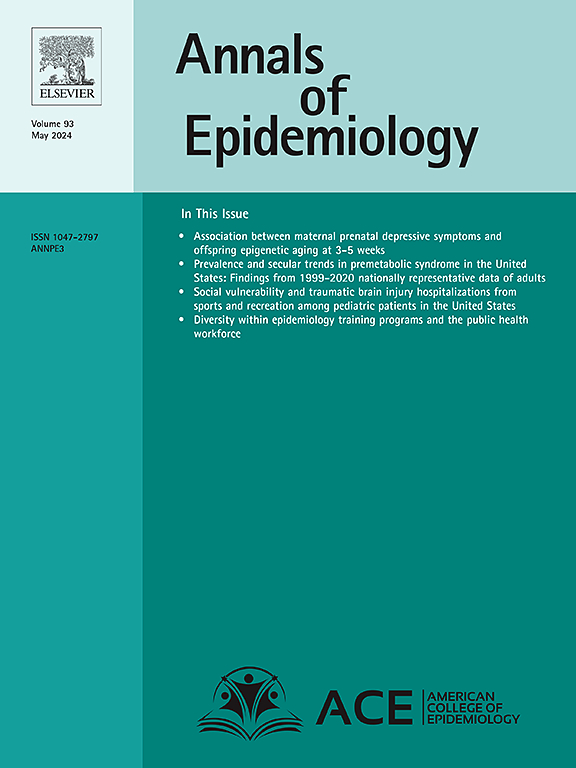电子烟使用和重金属暴露:来自韩国国家健康和营养检查调查的证据。
IF 3.3
3区 医学
Q1 PUBLIC, ENVIRONMENTAL & OCCUPATIONAL HEALTH
引用次数: 0
摘要
目的:本研究调查了韩国人群中电子烟(电子烟)使用与血清重金属(铅、汞和镉)浓度之间的关系,利用了韩国国家健康和营养检查调查(KNHANES)的数据,这是一项具有全国代表性的横断面调查。方法:对KNHANES 2013年、2016年和2017年的数据进行分析。参与者被分为电子烟使用者(曾经使用电子烟的人,包括同时使用传统香烟的双重使用者)、传统吸烟者(一生中至少吸过100支传统香烟[5包],但不吸电子烟的人)和非吸烟者(从未使用过电子烟,从未吸过传统香烟或吸烟少于100支的人)。采用线性回归模型评估吸烟状况与重金属浓度之间的关系,调整协变量包括年龄、性别、收入、教育程度和健康行为。根据性别、年龄和肥胖状况进行亚组分析。结果:电子烟使用者的血清重金属浓度明显高于非吸烟者。铅含量升高10.0 %(指数β = 1.100;p 结论:与只吸烟的卷烟相比,电子烟和传统卷烟的双重使用与重金属暴露增加有关。这些发现强调需要有针对性的公共卫生干预措施和更严格的监管标准,以解决与电子烟使用相关的风险。本文章由计算机程序翻译,如有差异,请以英文原文为准。
Electronic cigarette use and heavy metal exposure: Evidence from the Korea National Health and Nutrition Examination Survey
Purpose
This study investigated the association between electronic cigarette (e-cigarette) use and serum concentrations of heavy metals (lead, mercury, and cadmium) in the Korean population, utilizing data from the Korea National Health and Nutrition Examination Survey (KNHANES), a nationally representative cross-sectional survey.
Methods
Data from KNHANES 2013, 2016, and 2017 were analyzed. Participants were classified as e-cigarette users (individuals who had ever used e-cigarettes, including dual users who had also used conventional cigarettes), conventional smokers (individuals who had smoked at least 100 conventional cigarettes [5 packs], but not e-cigarettes, in their lifetime), and non-smokers (individuals who had never used e-cigarettes and either never smoked conventional cigarettes or smoked fewer than 100 cigarettes). Linear regression models were employed to evaluate the association between smoking status and heavy metal concentrations, adjusting for covariates including age, sex, income, education, and health behaviors. Subgroup analyses were performed based on sex, age, and obesity status.
Results
E-cigarette users exhibited significantly higher serum concentrations of heavy metals than non-smokers. Lead levels were 10.0 % higher (exponentiated β = 1.100; p < 0.001), mercury levels were 13.7 % higher (β = 1.137; p < 0.001), and cadmium levels were 61.4 % higher (β = 1.614; p < 0.001). Conventional smokers demonstrated elevated levels of these metals compared to non-smokers, but generally lower levels than e-cigarette users. Subgroup analyses revealed stronger associations among younger participants, males, and individuals with obesity, particularly for cadmium.
Conclusions
Dual use of e-cigarettes and conventional cigarettes is associated with elevated exposure to heavy metals compared to exclusive smoking cigarettes. These findings highlight the need for targeted public health interventions and stricter regulatory standards to address the risks associated with e-cigarette use.
求助全文
通过发布文献求助,成功后即可免费获取论文全文。
去求助
来源期刊

Annals of Epidemiology
医学-公共卫生、环境卫生与职业卫生
CiteScore
7.40
自引率
1.80%
发文量
207
审稿时长
59 days
期刊介绍:
The journal emphasizes the application of epidemiologic methods to issues that affect the distribution and determinants of human illness in diverse contexts. Its primary focus is on chronic and acute conditions of diverse etiologies and of major importance to clinical medicine, public health, and health care delivery.
 求助内容:
求助内容: 应助结果提醒方式:
应助结果提醒方式:


